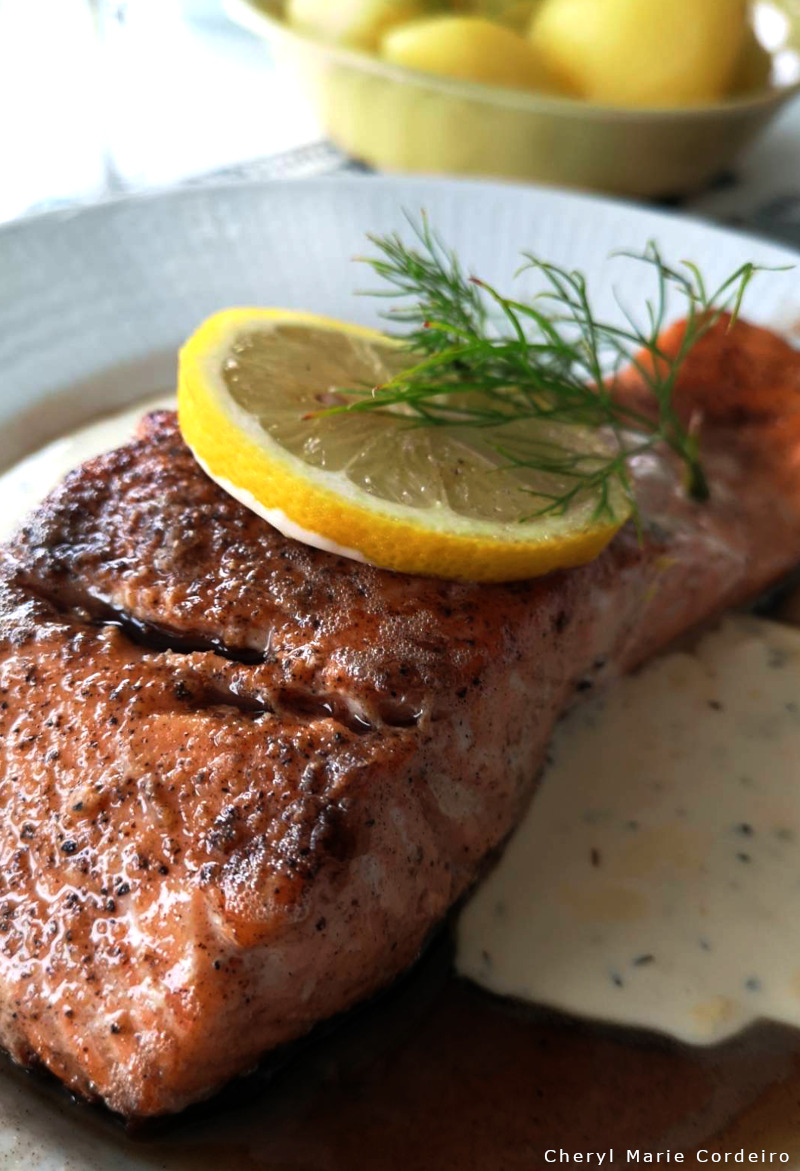Salmon from Hiddenfjörd, Faroe Islands, Denmark, topped with a sliver of dill from our garden.
Text & Photo © CM Cordeiro & , JE Nilsson 2023
It’s been a while since I’ve delved deep into the origins of the fish gracing my dinner plate. Just a few days ago, I found myself at a bustling fish wagon in west central Gothenburg, pondering my choices for the upcoming meals. The seller, noticing my indecision, pointed to a luscious-looking salmon fillet, revealing its origins from the Faroe Islands.
Aquaculture, or fish farming, has seen exponential growth over the past few decades, making it the fastest-growing sector in the global food industry. Between 1980 and 2016, the industry witnessed an average annual growth rate of 8.2 percent, and from 2000 to 2016, it was 5.8 percent [1]. Salmon, in particular, has been a standout, showcasing significant growth.
While countries like Norway, Chile, Canada, and Scotland have traditionally dominated this industry, the mention of salmon from the Faroe Islands intrigued me. Over the past three decades, the Faroe Islands have emerged as a key player in salmon aquaculture, now ranking as the world’s fifth-largest producer, primarily driven by three main producers, Mowi, Bakkafrost and Luna (Hiddenfjord) [2].
Digging deeper into the origins of the salmon fillet in front of me, I learned it hailed from Hiddenfjord,the only 100% Faroese family-owned enterprise renowned for producing top-tier salmon. Their secret? Raising salmon in some of the world’s most exposed farming sites. This unique environment imparts a distinct clean taste and unparalleled quality to the fish. The quality of feed and specific feeding regimes are instrumental in determining the attributes of Atlantic salmon. By adjusting the energy content of the feed and the feeding schedule, producers can influence key quality aspects, such as fat content and fillet firmness [3].
Hiddenfjord takes its commitment to quality a step further. They employ a stress-free harvesting and gutting technique, ensuring the fish is cleaned, packed, and ready for sale in under three hours from its last swim in the Atlantic. This rapid transition from ocean to package is pivotal in preserving the salmon’s natural flavor and firm texture. Moreover, their farming practices are free from antibiotics and hormones, ensuring a natural and healthy product.
For the culinary enthusiasts and food scientists out there, mathematical models can guide you in predicting the heating profile of salmon across various cooking methods, including oven baking, pan-frying, immersion frying, and microwaving [4]. I opted for pan-frying with a touch of butter and a sprinkle of crushed black pepper. For a crispy skin, I used high heat at around 200°C. From package to plate, my meal was ready in a swift 15 minutes, making for a delightful and quick culinary experience.
References
[1] FAO (2020). The State of Food and Agriculture 2020. Overcoming water challenges in agriculture. Rome.
https://doi.org/10.4060/cb1447en
[2] Bjørndal, T., & Tusvik, A. (2020). Economic analysis of on-growing of salmon post-smolts. Aquaculture Economics & Management,24(4), 355–386.https://doi.org/10.1080/13657305.2020.1737272.
[3] Johnsen, C., Hagen, &., Adler, M., Jönsson, E., Kling, P., Bickerdike, R., …Bendiksen, E. (2011). Effects of feed, feeding regime and growth rate on flesh quality, connective tissue and plasma hormones in farmed Atlantic salmon ( Salmo salar L.). Aquaculture, 318(3), 343-354.
[4] Brookmire, L., Mallikarjunan, P., Jahncke, M., & Grisso, R. (2013). Optimum Cooking Conditions for Shrimp and Atlantic Salmon. Journal of Food Science, 78(2), S303-S313.
